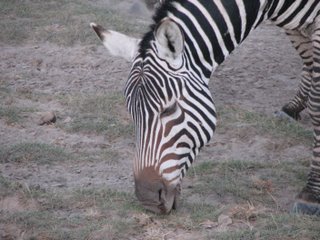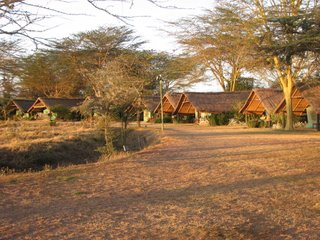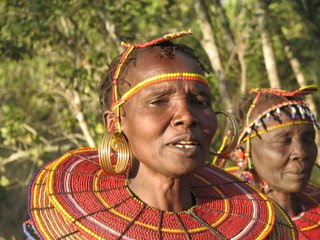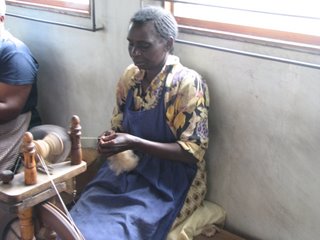
On the way to Amboseli, we visit the A.I.C. Kajaido Boarding School. The African Inland church started the school in 1959 with 20 girls. In 1964, after Kenya independence, the school was turned over to the government. It tries to address cultural problems. The biggest issue is that at around the age of 13, girls are subject to genital mutilation. The school is trying to help and educate girls who have run away to escape forced child marriages and genital mutilation, or who have faced other situations such as being raped, or being orphaned due to AIDS, or having physical disbilities. 90% of the girls are Maasai.
The school philosophy is that if they educate the girls, they educate a nation. They also function as a rescue center, so girls who know their families have plans to ‘circumcise’ them, can have a place to run to. They have an award winning music program, and a drama program to encourage them to communicate.
They teach English, Kiswahili, Science, Mathematics, and social studies. Some of the girls go on to high school and college. They need sponsors to pay for the higher education. “God always opens a door for us” the teacher says gratefully. The first grade could have children ranging from 6-16, depending on when they started their schooling. Some children need to walk 10k to get to school, so they need to be old enough to walk that far.
Ellen asked who takes care of the children after school. The answer was that a matron and dispensary are available for medical care. Clearly they weren’t thinking of the kind of childcare we are used to.
A sixth grade class sings for us. “I’m happy today so happy, in Jesus’ name I’m happy, because he has taken away my sins.” A couple of girls recite poems. They are eloquent, with intense voices and dramatic hand gestures. They are in the ‘speak-out’ drama club. The school motto is “determination and dedication to excellence.”
Although it is Sunday, they show us to a schoolroom to talk to some of the children. I chat with Tabitha, who asks how old I am, and when I ask her to guess politely suggests ’20?’ We have been warned not to ask the girls specifics about their background, since so many are victims of abuse of one sort or another, so I try to ask something more neutral. “How long have you been coming to school?” “A LOOONG TIME” she replies, “20 weeks”. She is 12. Her favorite subjects are science and match.

Then we are shown the dormitory – a long room with a row of bunks on each side. Each pair of bunks are abutted next to each other, and 2 girls share each bed, so in every 8’ by 6’ slot 8 girls are expected to sleep. It is abundantly clear why they need a new dormitory! If this were a prison, the inmates would sue for more space. Grand Circle (the parent company of OAT) is collecting money to build a dormitory. Many of us are glad to chip in.
The children are all in uniforms, which seems standard practice in Kenya. Most of the children are Christian, but they have a handful of Muslims. As we leave the school, we pass a mosque, which our trip leader explains is for the Somalian refugees in the neighborhood. He said that while the Maaasai who interact with the outer world often become Christian, they rarely become Muslim. In his words, they do not join ‘Islamology’.

Now back into the vans for the trip to Amboseli. My backside now understands why the inflatable seat cushions were recommended, although it is probably good that I don’t realize it will get worse later! After a long day’s drive, I’m wondering why we bother to keep switching camps, but as we approach Amboseli, it is immediately apparent that we will see different varieties of animals. I guess that was supposed to be obvious, but as a safari novice, I didn’t really grasp it until now. We pass a gerenuk hidden in the bush, as well as an elephant, spotted hyena, ostrich, yellow baboon, zebra, Thompson’s gazelle, and wildebeest. Due to the drought, the lake is dry, and we are able to drive straight across. The rutted path across the lake is actually smoother than the road was, but it surely is dusty. I finally realize that this is what those buff kerchiefs are for. This is a great solution. I pull one over my head, then slide it back over my hair, and tuck the back ends in at the nape of my neck. I don’t care if it looks silly, it saves my hair from that amazing phenomenon where dust and wind together create instant dreadlocks.
I had made the mistake of saving one of those little bananas from our boxed lunch. It was in the pocket of my cargo pants, and when I stood up in the van to spy the gerenuk, I didn’t realize I was mashing the banana until the pulp seeped thru the pocket, creating a wet slime. I asked our trip leader what to do with the crushed banana, and his only idea was to hold it in my hand for the next 22 kilometers. That did not sound like a plan to me, so I emptied out some toiletries from a baggie in my carry-on, and used that as a garbage bag.
We’re tired and dirty when we arrive at the Amboseli Serena. They greet us with welcome wet towels and passion fruit juice.
We can tell we are in mosquito country – even just in the lobby we are being attacked. No one has any repellent on, since it wasn’t a problem before. I wish we could just move on to our rooms, but the registration process is taking some time. I’ve got my carryon, my daybag, my camera and binoculars, and I’m trying to slather on bug repellent, and just don’t have enough hands, but once I’m sticky with the repellent I don’t want to mess up my camera by even trying to put it away. Finally we’re given our keys and our room steward carries our duffles and leads us to our room. It is attractive and luxurious, only slightly marred by the black millipedes sprinkled all over the floor. Idelle steps on one and it crunches underfoot and breaks in half. The front half keeps slithering onward. The beds are shrouded in mosquito netting, which is white so it looks romantic rather than utilitarian. There are so many light switches we can’t figure them out. It is appealing to be back in the land of full-fledged electricity, after the 11 watt bulbs at Sweetwater’s -- that's not hyperbole, they actually were 11 watts!
I don’t want to inadvertently research what kind of bugs are attracted by banana pulp, so I pull off my pants as soon as I’m in my room, so I can send them to the laundry. My roommate puts me on banana restriction. From now on when we get a boxed lunch and I’m tempted to save the banana she just gives me a look. Thanks to her watchful eye, I don’t end up with any more laundry emergencies. It is working so well rooming together. I think it actually helps that we don’t know each other, because we don’t have any ‘hot buttons’ to push.
Dinner at the Amboseli Serena was the best meal in Africa so far. I had a light cream of pea soup and a small steak. Dennis tells a funny story about the school. He asked a girl to read something for him, and she reads from the Bible, Romans 8:8. Then he asked her if she understood and she said not really, so he ended up having to try to explain it. While he doesn’t claim to be a believer, it sounds like his explanation was pretty good. He said that if another girl took something from her and she hurt her instead of forgiving her, it would not please God.
The lodge employs Maasai as monkey chasers. They stand with sticks, and watch, and chase off the monkeys when they try to climb on the outside tables, or run into the dining room.








